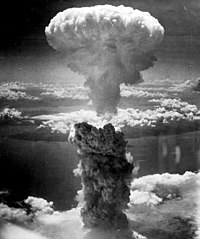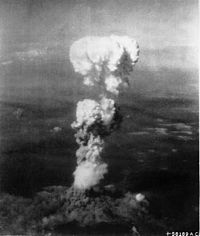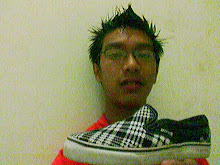Atomic bombings of Hiroshima and Nagasaki
From Wikipedia, the free encyclopedia

The atomic bombings of Hiroshima and Nagasaki were nuclear attacks at the end of World War II against the Empire of Japan by the United States at the order of U.S. President Harry S. Truman on August 6 and 9, 1945. After six months of intense firebombing of 67 other Japanese cities, the nuclear weapon "Little Boy" was dropped on the city of Hiroshima on Monday[1], August 6, 1945, followed on August 9 by the detonation of the "Fat Man" nuclear bomb over Nagasaki. These are to date the only attacks with nuclear weapons in the history of warfare.[2]
The bombs killed as many as 140,000 people in Hiroshima and 80,000 in Nagasaki by the end of 1945,[3] roughly half on the days of the bombings. Since then, thousands more have died from injuries or illness attributed to exposure to radiation released by the bombs.[1] In both cities, the overwhelming majority of the dead were civilians.
Six days after the detonation over Nagasaki, on August 15, Japan announced its surrender to the Allied Powers, signing the Instrument of Surrender on September 2, officially ending the Pacific War and therefore World War II. (Germany had signed its Instrument of Surrender on May 7, ending the war in Europe.) The bombings led, in part, to post-war Japan adopting Three Non-Nuclear Principles, forbidding that nation from nuclear armament.[4]



















No comments:
Post a Comment